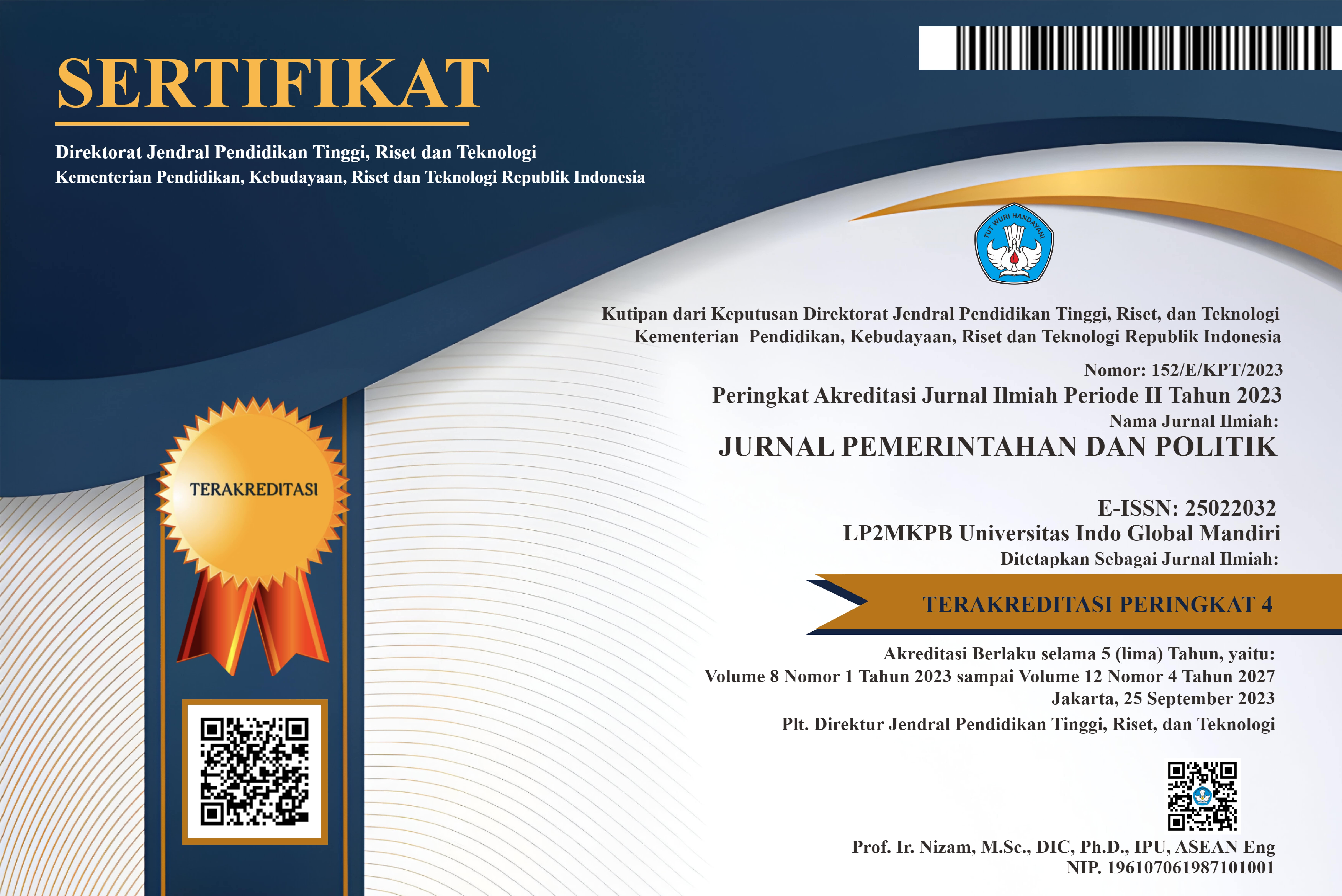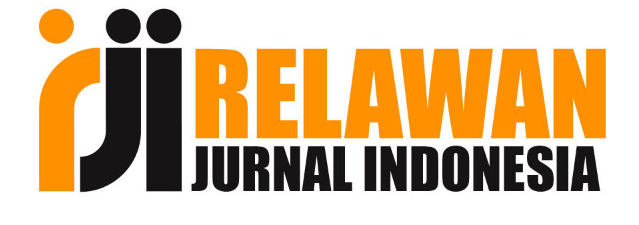Media Sosial dan Politisi Perempuan di Indonesia: Analisis Konten Pada Sembilan Akun Instagram Perempuan Anggota Legislatif
DOI:
https://doi.org/10.36982/jpg.v7i4.2536Abstract
Instagram, sebuah platform media sosial berbasis foto dan video, merupakan salah satu media sosial yang jadi tren di kalangan politisi perempuan sebagai media komunikasi politik. Terdapat banyak literatur mengenai penggunaan Instagram oleh para politisi, termasuk juga politisi perempuan, khususnya ketika kampanye menjelang pemilihan umum. Namun, masih sedikit literatur yang meneliti penggunaan media sosial oleh politisi perempuan setelah mereka duduk di bangku legislatif. Untuk mengisi kekosongan tersebut, penelitian ini bertujuan untuk mendeskripsikan bagaimana politisi perempuan, dalam hal ini perempuan anggota legislatif, menggunakan Instagram sebagai media komunikasi politik pasca pemilihan umum. Penelitian ini menggunakan multiple case study dengan mengevaluasi konten foto, video, dan keterangan konten yang diunggah ke Instagram dari sembilan perempuan anggota legislatif yang masing-masingnya berasal dari sembilan partai politik yang berbeda. Dalam mengambil data, penelitian ini menggunakan alat bantu perangkat lunak bernama Instagram Scrapper yang secara otomatis mengumpulkan gambar, video, teks, komentar, dan jumlah likes pada akun Instagram dari sembilan perempuan anggota legislatif dalam jangka waktu Januari 2020 hingga Desember 2020. Hasil penelitian menunjukkan bahwa politisi perempuan menggunakan Instagram untuk mengunggah konten yang bervariasi, tidak hanya mengenai politik. Dalam penelitian ini, terlihat bahwa perempuan anggota legislatif mengunggah konten-konten yang dapat diklasifikasikan sebagai konten atribut feminin, konten politik berupa kegiatan sebagai anggota legislatif, atribut keagamaan, atribut nasionalisme, hingga gaya hidup sosialita.
Kata Kunci: Politisi Perempuan, Komunikasi Politik, Media Sosial, Instagram, Analisis KontenReferences
Aaldering, L., & Pas, D. J. Vander. (2020). Political Leadership in the Media: Gender Bias in Leader Stereotypes during Campaign and Routine Times. British Journal of Political Science, 50(3), 911–931. https://doi.org/10.1017/S0007123417000795
Amaliatulwalidain, Putri, D. E., & Kencana, N. (2022). Peran Politik Perempuan Pada Dewan Pimpinan Cabang Partai Persatuan Pembangunan Kota Palembang. Jurnal Pemerintahan Dan Politik, 7(1), 40–46. http://ejournal.uigm.ac.id/index.php/PDP/article/view/2009/1500
Beers, S. (2014). Shallow or rational public spheres? Indonesian political parties in the twitter-sphere. SEARCH Journal of Media and Communication Research, 6(2), 1–23. https://doi.org/10.7603/s40931-014-0001-8
Bossetta, M. (2018). The Digital Architectures of Social Media: Comparing Political Campaigning on Facebook, Twitter, Instagram, and Snapchat in the 2016 U.S. Election: Https://Doi.Org/10.1177/1077699018763307, 95(2), 471–496. https://doi.org/10.1177/1077699018763307
Diekman, A. B., & Eagly, A. H. (2000). Stereotypes as Dynamic Constructs: Women and Men of the Past, Present, and Future. Personality and Social Psychology Bulletin, 26(10), 1171–1188. https://doi.org/10.1177/0146167200262001
Fahmy, S., Bock, M. A., & Wanta, W. (2014). Visual communication theory and research: A mass communication perspective. In Visual Communication Theory and Research: A Mass Communication Perspective. Palgrave Macmillan. https://doi.org/10.1057/9781137362155
Gibson, R. K., & McAllister, I. (2011). Do Online Election Campaigns Win Votes? The 2007 Australian “YouTube†Election. Political Communication, 28(2), 227–244. https://doi.org/10.1080/10584609.2011.568042
Grant, W. J., Moon, B., & Grant, J. B. (2010). Digital Dialogue? Australian Politicians’ use of the Social Network Tool Twitter. Http://Dx.Doi.Org/10.1080/10361146.2010.517176, 45(4), 579–604. https://doi.org/10.1080/10361146.2010.517176
Hart, W., Ottati, V. C., & Krumdick, N. D. (2011). Physical Attractiveness and Candidate Evaluation: A Model of Correction. Political Psychology, 32(2), 181–203. https://doi.org/10.1111/j.1467-9221.2010.00812.x
Kapoor, S., & Dubey, M. (2020). THE IMPACT AND ROLE OF MEDIA FOR PEACE AND HUMAN SECURITY DURING COVID -19 CRISES. Journal of Content Community and Communication, 12, 210–218. https://doi.org/10.31620/JCCC.12.20/19
Kariem, M. Q., Akhbar, M. A., & Oktarena, C. D. (2022). COLLABORATIVE GOVERNANCE DALAM MASA RESES DPRD KABUPATEN BANYUASIN. Jurnal Pemerintahan Dan Politik, 7(1), 68–74.
Krippendorff, K. (2013). Content Analysis: An Introduction to Its Methodology. SAGE Publications Ltd.
Kristof, J., & Spierings, N. (2016). Social Media, Parties, and Political Inequalities. Palgrave Macmilla.
Laestadius, L. (2017). Instagram. In L. Sloan, & A. Quan-Haase (Eds). The SAGE Handbook of Social Media Research Methods. In The SAGE Handbook of Social Media Research Methods (pp. 573–592). SAGE Publications Ltd. https://doi.org/10.4135/9781473983847.N34
Lalancette, M., & Raynauld, V. (2017). The Power of Political Image: Justin Trudeau, Instagram, and Celebrity Politics: Https://Doi.Org/10.1177/0002764217744838, 63(7), 888–924. https://doi.org/10.1177/0002764217744838
Malev, M. (2021). Governing on Twitter and others: social media as a political communication form. Dmexco.Com. https://dmexco.com/stories/social-media-political-communication/
Molek-Kozakowska, K., & Kampka, A. (2021). Creative reconstructions of political imagery in an Instagram-based election campaign: implications for visual rhetorical literacy. Creativity Studies, 14(2), 307–322. https://doi.org/10.3846/CS.2021.14524
Musdalifah, F. S. (2021). Consumerism on Clubhouse Exclusivity from Jean Baudrillard’s Perspective. Warta ISKI, 4(1), 81–88. https://doi.org/10.25008/wartaiski.v4i1.111
Nee, R. C., & De Maio, M. (2019). A ‘Presidential Look’? An Analysis of Gender Framing in 2016 Persuasive Memes of Hillary Clinton. Https://Doi.Org/10.1080/08838151.2019.1620561, 63(2), 304–321. https://doi.org/10.1080/08838151.2019.1620561
Patterson, T. E. (2016). Social media: Advancing women in politics. In Women in Parliaments Global Forum. https://www.womenpoliticalleaders.org/wp-content/uploads/2016/10/WIP-Harvard-Facebook-Study_Oct2016.pdf
Ponton, D. M. (2010). The female political leader: A study of gender-identity in the case of Margaret Thatcher. Journal of Language and Politics, 9(2), 195–218. https://doi.org/10.1075/JLP.9.2.02PON
Prihatini, E. S. (2020). Women and social media during legislative elections in Indonesia. Women’s Studies International Forum, 83. https://doi.org/10.1016/J.WSIF.2020.102417
Rheault, L., Rayment, E., & Musulan, A. (2019a). Politicians in the line of fire: Incivility and the treatment of women on social media: Https://Doi.Org/10.1177/2053168018816228, 6(1). https://doi.org/10.1177/2053168018816228
Rheault, L., Rayment, E., & Musulan, A. (2019b). Politicians in the line of fire: Incivility and the treatment of women on social media. Research & Politics, 6(1), 205316801881622. https://doi.org/10.1177/2053168018816228
Ritchie, J. (2013). Creating a Monster. Http://Dx.Doi.Org/10.1080/14680777.2011.647973, 13(1), 102–119. https://doi.org/10.1080/14680777.2011.647973
Saluja, N., & Thilaka, D. N. (2021). Women Leaders and Digital Communication: Gender Stereotyping of Female Politicians on Twitter. Journal of Content, Community & Communication, 13(June 2021). https://www.amity.edu/gwalior/jccc/pdf/jun_19.pdf
Schill, D. (2012). The Visual Image and the Political Image: A Review of Visual Communication Research in the Field of Political Communication. Http://Dx.Doi.Org/10.1080/15358593.2011.653504, 12(2), 118–142. https://doi.org/10.1080/15358593.2011.653504
Strandberg, K. (2013). A social media revolution or just a case of history repeating itself? The use of social media in the 2011 Finnish parliamentary elections: Http://Dx.Doi.Org/10.1177/1461444812470612, 15(8), 1329–1347. https://doi.org/10.1177/1461444812470612
Thummy, F. A. (2015). Social Media as a Tool of Political Communication. GRIN Verlag. https://www.grin.com/document/513240
Tran, M. (2016). An Instagram is worth a thousand words. The Utilization of Instagram as a key social media strategy. Case: Valona Design. Haaga Helia, University of Applied Sciences.
Turnbull-Dugarte, S. J. (2019). Selfies, Policies, or Votes? Political Party Use of Instagram in the 2015 and 2016 Spanish General Elections: Https://Doi.Org/10.1177/2056305119826129, 5(2), 205630511982612. https://doi.org/10.1177/2056305119826129
Yin, R. K. (2014). Cast Study Research: design and methods. Sage. https://doi.org/10.1017/CBO9780511803123.001












